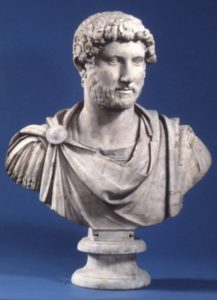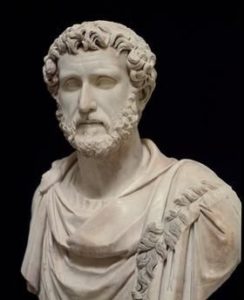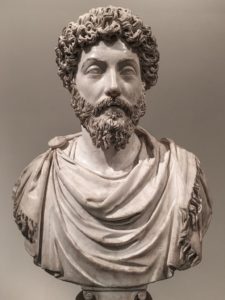Below is a detailed article about the different rulers in Britain that ruled during the Roman era. The Romans invaded England in 43 AD and continued ruling for the next four hundred years. There were different rulers throughout this period that brought in different changes in Roman Britain in terms of politics, administration, and government. Let us learn about the different rulers below.
Who were the Roman Rulers in Britain?
Contents
Emperor Trajan
Trajan’s full name was Marcus Ulpius Traianus. He was born in Italy, and so his family had their origins in northern Italy. He reigned the Roman empire from 98 AD to 117 AD. He was known for his benevolence and public projects. He was known for improving road systems, creating aqueducts and building the famous Roman baths. He was a successful ruler and is known for his major conquests in the East.

He was the adopted son of Emperor Nerva who died a natural death. Trajan succeeded his father and inherited the throne of the Roman empire. He had a good military reputation. His birth father was a military man too. He was a commander in the Jewish war. He was highly respected by Nerva, the then Roman emperor.
After becoming an emperor in 99 AD, he was assisted by the writer Pliny who wrote many pieces of literature about him. Trajan was not considered as effective as Nerva or Domitian but was definitely an able ruler. He was known for his justice, bravery, and simplicity. He managed a good government and introduced many reforms for public welfare. He provided for the poor and helped them raise their children, he improved road systems for the public and freed prisoners that were unnecessarily tied by Domitian.
He had a special interest in warfare and was involved in 3 wars – 2 with the Dacians and one on the eastern frontier. He made all the Roman colonies including Roman Britain the ‘Land of the Romans’. He built the Forum and the Trajan’s Column. These are two gifts that he gave to Italy that is a tourist attraction even today.
In August 117 AD, Trajan died in Selinus out of a stroke while he was on his way to Rome from Syria. The city of Selinus was then known as Trajanopolis. He was 63 years old when he died. He and his wife were childless which is why they adopted Hadrian. Hadrian was a commander of the army in Antioch. Hadrian, as a commander, conquered the Euphrates which is present-day Assyria, Mesopotamia, and Armenia.
Emperor Hadrian
Hadrian was a commander of the army in Antioch. Hadrian, as a commander, conquered the Euphrates which is present-day Assyria, Mesopotamia, and Armenia. He succeeded his father – Emperor Trajan in 117 AD and reigned the Roman empire until 138 AD. He was one of the famous five good emperors who had a just rule. He is famous for all his community-building works and the many constructions he made in the Roman empire, especially the Hadrian’s Wall in Roman.

He was born in Hispania, which is present-day Seville, Spain. He was in the Roman military and served from the time of Emperor Nerva. All of Hadrian’s service whilst being a military commander is well documented. As an emperor, Hadrian spent less time in Rome. He was on expeditions more than half the time and was known for sleeping and eating with the army of common soldiers. His regime was a peaceful time throughout the Roman empire.
He was known as ‘Graeculus’ since he was in love with Greek literature and historic legacy. He visited Greece twice a year. He built the cities in Egypt and Asia Minor, also some parts of Greece. The Athenians constructed the Arch of Hadrian to honor him. He constructed the Temple of Zeus. He founded a city in Egypt called Antinopolis in memory of the death of Antinous, a man he was very fond of. Many of the structures by Hadrian survive even today – intact. Many are even World Heritage sites around the world.
His constructions denoted his love for architecture. Out of all the constructions he gave to the world, the most significant is Hadrian’s wall constructed in Britain. In Latin, it is called Vallum Hadriani. The construction began in 122 AD and went on for 6 years. Hadrian paid a visit to the Roman Britain province shortly. The whole purpose of the wall was to show the power and reach of the Roman empire. It was originally 9.7 feet which is 3 meters high!
It stretches across 120 Km which is 73 miles. The engineering is such that it stands still even on uneven terrain. There were also many Roman forts and villas constructed alongside the wall. A few ruins of them can be seen today and are a tourist spot of attraction.
In his later years, Hadrian finally returned to Rome, he was mostly found peacefully writing poems and attending the administrative officers. He died of a heart attack in 138 AD and was succeeded by Antoninus Pius – Hadrian’s adopted son.
Emperor Antoninus
Antoninus Pius was the emperor of the Roman empire from 138 AD to 161 AD. He was born in Lanuvium which is to the south of Rome. He was the second-longest reigning Roman emperor of all times. He was the adopted son of Emperor Hadrian and inherited the throne after his father died. He was just and compassionate and much liked by the Roman people.

Even though he was not Hadrian’s first choice, he proved himself to be one of the good rulers in the Roman era. He lasted for quite a long time too which was unexpected at the time. He was one of the rulers that did not oppress the Christians at the time. He carried out the same responsibilities as his father and was loyal to his memory.
However, unlike Hadrian, Antoninus spent most of his time in the city of Rome. This was for his own safety and also for the fact that it was expensive for the emperor function anywhere else in the Roman empire. His administration was the same as his father. His sense of judgment was fair and impartial. He even freed many prisoners and claimed that it was only his fathers wish. Finance management was done extremely well and as a result, the trade and commerce during his reign took a high peak. He also completed Hadrian’s incomplete projects and built the monuments Hadrian had begun.
His reign marked the 900th year of the Roman empire. He also built the Antonine wall which was 40 miles north of Firth of Clyde. The wall was in Scotland and built to show his valor and superiority. The partial reason was to keep the barbarians away.
He died in 161 AD out of fever. His reign was a time of relative peace in the Roman empire.
Emperor Marcus Aurelius

Another long-reigning Roman Emperor was Marcus Aurelius. He was also included in one of the five good Roman Rulers Rome ever had. His reign began in 161 AD until 180 AD. He is also known for his writings namely ‘Meditations’ that was published by him. He was introduced to philosophy at a young age and therefore, had the flair for it. He wrote his book while he was in his fifties and on a military campaign.
He is generally referred to as the philosophical ruler and was known to use philosophy in his private and public life. He was glorified as he always placed peoples needs before his. He was definitely the most loved ruler in the Roman empire. His name is well known because of the movie ‘Gladiator’ where he is the father of Commodus.
He is seen to have adopted the Cynic approach to life – simple with few possessions. He was appreciative of his father – Emperor Antoninus which is determined from his book – Meditations. Not only did he study philosophy but he also studied law and arms. He had the knowledge of an imperial gentleman.
When it came to administration, Aurelius followed the policies and pathways of Emperor Hadrian. He introduced some reforms for the welfare of the poor and rewarded the military with greater honor and a better price and standard of living. He encouraged arts and education which contributed to a better economy. In order to maintain peace, he did not persecute the Christians however, he was of Stoic belief and did not understand Christianity.
He campaigned against the Germanic tribes and safeguarded the Roman Britain boundaries. Aurelius defeated these Germanic tribes and died two years after the conquest. He was succeeded by his son – Commodus who became the next Roman Emperor. He was the sole emperor for 12 years after 3 years of being a joint emperor. Commodus was assassinated in the Roman palace. He was strangled while he was taking a bath.
These Roman Rulers set a wide example as to how a kingdom is administered throughout the world.